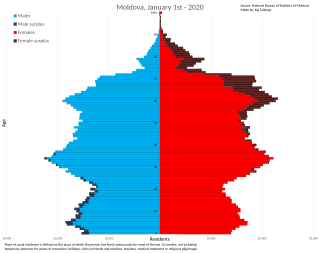Related Research Articles

Demographic features of the population of Republic of Moldova include distribution, ethnicity, languages, religious affiliation and other statistical data.

Tiraspol is the capital and largest city of Transnistria, a breakaway state of Moldova, where it is the third-largest city. The city is located on the eastern bank of the Dniester River. Tiraspol is a regional hub of culture, economy, tourism, and light industry, such as furniture and electrical goods production.

Transnistria, officially known as the Pridnestrovian Moldavian Republic and locally as Pridnestrovie, is a landlocked breakaway state internationally recognized as part of Moldova. It controls most of the narrow strip of land between the Dniester river and the Moldova–Ukraine border, as well as some land on the other side of the river's bank. Its capital and largest city is Tiraspol. Transnistria is officially designated by the Republic of Moldova as the Administrative-Territorial Units of the Left Bank of the Dniester or as Stînga Nistrului.

The politics of Transnistria, an unrecognised de facto state situated de jure within the Republic of Moldova in Eastern Europe, take place in a framework of a semi-presidential republic, whereby the president is head of state and the prime minister is head of government. Executive power is exercised by the government. Legislative power is vested in both the government and parliament. Officially, Transnistria has a multi-party system and a unicameral parliament, called the Supreme Council. The president is elected by popular vote. The latest parliamentary elections were held in November 2020.

Grigoriopol is a town in the Administrative-Territorial Units of the Left Bank of the Dniester, Moldova. It is the seat of the Grigoriopol District of Transnistria. The city is located on the left (eastern) bank of the river Dniester, in central Transnistria.

The Transnistria War was an armed conflict that broke out on 2 November 1990 in Dubăsari between pro-Transnistria forces, including the Transnistrian Republican Guard, militia and neo-Cossack units, which were supported by elements of the Russian 14th Army, and pro-Moldovan forces, including Moldovan troops and police.

Camenca District is a district of Transnistria, a breakaway republic which is internationally recognized as part of Moldova. Its seat is the town of Camenca. The district contains this town and twelve communes :

The Transnistria conflict is an ongoing frozen conflict between Moldova and the unrecognized state of Transnistria. Its most active phase was the Transnistria War. There have been several unsuccessful attempts to resolve the conflict. The conflict may be considered to have started on 2 September 1990, when Transnistria made a formal sovereignty declaration from Moldova.

This is the history of Transnistria, officially the Pridnestrovian Moldavian Republic (PMR), an unrecognised breakaway state that is internationally recognised as part of Moldova. Transnistria controls most of the narrow strip of land between the Dniester river and the Moldovan–Ukrainian border, as well as some land on the other side of the river's bank.

Chițcani is a commune in Căușeni District, in south-eastern Moldova. It consists of the village Chițcani and two small villages (hamlets), Merenești and Zahorna. Chițcani is situated to the south-east of the city of Tighina (Bender). The locality, although situated on the right (western) bank of the river Dniester, is under the control of the breakaway Transnistrian authorities. On the opposite side of the river lies the city of Tiraspol.
The 2004 Transnistrian census was organized in Transnistria at roughly the same time that Moldova held its own census, which Transnistria refused to participate in out of principle and deference to its September 2, 1990 declaration of independence.

Gîsca is a village near in Căușeni District, Moldova, composed of a single village with the same name, population 4,841 at the 2004 Census. The locality, although situated on the right (western) bank of the river Dniester, immediately to the south-west of the city of Tighina (Bender), in the Bessarabian, not Transnistrian part of Moldova, is under the control of the breakaway Transnistrian authorities.

A demographic history of Transnistria shows that Transnistria has been home to numerous ethnic groups, in varying proportions, over time.
Maiac is an urban-type settlement or town in the Grigoriopol District, Transnistria, Moldova, eleven kilometres northeast of Grigoriopol, on the Ukrainian border. According to the unofficial census of 2004, the population of the town was 1,221 inhabitants, of which: 351 (28.74%) Moldovans (Romanians), 582 (47.66%) Ukrainians and 239 (19.57%) Russians.
Speia is a village in the Grigoriopol sub-district of Transnistria, Moldova. It is currently under the administration of the breakaway government of the Transnistrian Moldovan Republic.
Caragaș is a village in the Slobozia District of Transnistria, Moldova. It is currently under the administration of the breakaway government of the Transnistrian Moldovan Republic.
Corotna is a village in the Slobozia District of Transnistria, Moldova. It has since 1990 been administered as a part of the breakaway Pridnestrovian Moldavian Republic (PMR). The population of the village is estimated to up to 4 thousand people, mainly Moldovans.
The 2014 Moldovan census was held between 12 and 25 May 2014. It was organized by National Bureau of Statistics of the Republic of Moldova.

The government of Transnistria, a breakaway state internationally recognized as part of Moldova, has requested annexation by Russia numerous times. Transnistria is a territory that separated itself from Moldova due to fear of a possible unification of the latter with Romania. This sparked the Transnistria War, in which Russian-backed Transnistria managed to stay separate from Moldova. Despite this, today Transnistria is legally and internationally considered part of Moldova.

Since the outbreak of the Transnistria conflict, there have been efforts and proposals to reincorporate the unrecognized state of Transnistria into Moldova.
References
- 1 2 3 "Перепись населения ПМР". Privet PMR (in Russian). 9 March 2017. Archived from the original on 14 August 2018.
- ↑ Benea, Radu (16 May 2016). "Transnistria a pierdut "un oraș"" (in Romanian). Radio Europa Liberă Moldova.